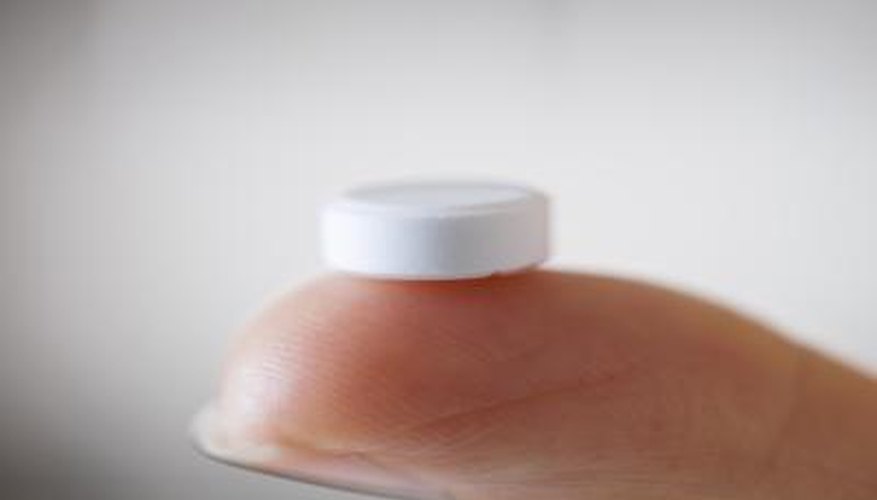If you're uncertain about a stray pill in your medicine cabinet, purse or the pocket of your teenager's jeans, there are several ways to identify it. A variety of tools available online and at your public library make it fairly simple to identify prescription drugs or over-the-counter medications and supplements. Elderly people and those who take several different pills per day have an increased chance of confusing medications. Since some medications are taken on an "as-needed" basis, it's not uncommon to lose track of pills and their purposes.
- If you're uncertain about a stray pill in your medicine cabinet, purse or the pocket of your teenager's jeans, there are several ways to identify it.
- Since some medications are taken on an "as-needed" basis, it's not uncommon to lose track of pills and their purposes.
Drug identification websites ask you to describe the questionable pill in detail. You will be asked to carefully observe the markings, shape, colour and type of pill, whether it's a tablet, capsule or caplet. Chemist's shops often substitute a generic version for the brand name medication that you've been taking. You may be accustomed to swallowing a small, pink caplet with a certain marking on it, and then be surprised when your prescription refill changes into a blister pack of large, two-toned tablets with a different marking. In such cases, pill identification resources can determine whether the pills are a generic substitute or the wrong medication.
The most definitive tool for identifying a pill is the marking or imprint on a tablet, capsule or caplet. The marking can be a graphic logo or alpha and numeric characters (numbers and letters) on one or both sides of a pill. A pill imprint or engraving can be more difficult to determine and you may need a magnifying glass to clearly see it. Some pills show a different letter or number when turned upside down. For example, the marking may appear as W9 from one perspective, and 6M when turned around. If you remain confused after consulting a pill identifier, contact your chemist's or doctor.
- The most definitive tool for identifying a pill is the marking or imprint on a tablet, capsule or caplet.
- The marking can be a graphic logo or alpha and numeric characters (numbers and letters) on one or both sides of a pill.
Pills come in a variety of shapes, which further help distinguish one from another. Correctly describing the shape of a pill is an important step in the identification process. Common pill shapes include round, oblong, oval, triangular, square, rectangular, diamond, half circle, teardrop and scalloped. There are also pills shaped with three, four, five, six, seven or eight sides, and others with unusual shapes.
Pills are made in many different colours and shades. Among the most common colours are white, off-white, tan, pink, peach, yellow, red, orange, green, blue, purple, black, brown, grey and clear. Some pills have two colours; one half of a capsule may be white while the other half is blue. Pill identification sites include colour charts that help you determine pill colours.
- Pills are made in many different colours and shades.
- Some pills have two colours; one half of a capsule may be white while the other half is blue.

When a pill is scored, it has an indentation or recess -- usually a straight line -- for cutting a pill in half or dividing it into equal parts. A scored pill is easier to split and also helps distinguish it. You can save money on some prescriptions if your doctor prescribes a higher dose with instructions to cut the pills in half.
TIP
The databases of online drug identification websites are regularly updated and may be the most current resources for information about prescription and over-the-counter drugs. Drug websites ask for a description of the questionable pill, and then identify it based on your input. They also provide information about drug side effects and dosages. If you are unable to positively identify a pill on one website, try one or two other sites until you are certain of the pill in question. Brand new pills may not be in website databases yet, and in such cases you should contact your pharmacy. The standard, published prescription drug reference tool for years has been Physician's Desk Reference, which lists prescription medications and photographs of pills in different dosages.
WARNING
Every year deaths and injuries occur because of medication errors. This can be avoided by correctly identifying questionable medications. If you are unable to identify your pills with absolute confidence using a pill identifier, consult your chemist's or doctor. Schoolteachers, administrators or nurses may find a pill that needs to be quickly identified and/or administered to a student. Law enforcement officers may also need to make quick decisions based on pills that they find in a person's possession or in other situations. Online resources help make definitive drug identification possible in seconds or minutes, if necessary.
